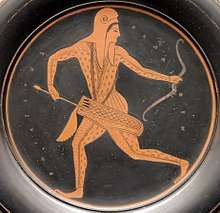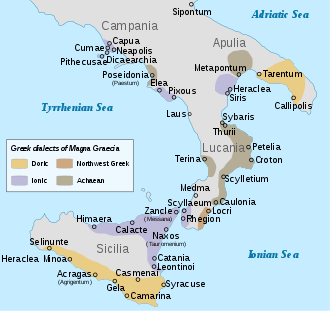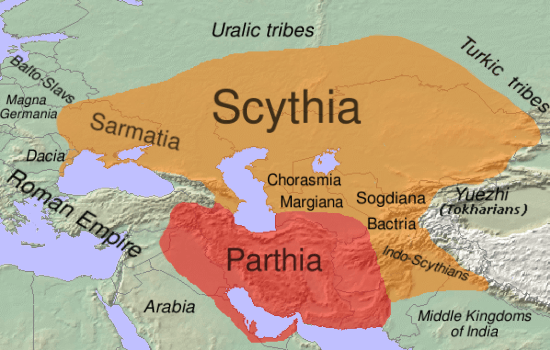Scythian archers
The Scythian archers were a hypothesized police force of 5th- and early 4th-century BC Athens that is recorded in some Greek artworks and literature. The force is said to have consisted of 300 armed Scythians (a nomadic people living in the Eurasian Steppe) who were public slaves in Athens. They acted for a group of eleven elected Athenian magistrates "who were responsible for arrests and executions and for some aspects of public order" in the city.
| Scythian archers Speusinioi Σπευσίνιοι | |
|---|---|
 An Attic red-figure vase-painting of a Scythian archer by Epiktetos, 520–500 BC | |
| Agency overview | |
| Formed | 5th century BC |
| Dissolved | 4th century BC |
| Employees | 300–1,200[1][2] |
| Legal personality | Government agency |
| Jurisdictional structure | |
| National agency | Classical Athens |
| Operations jurisdiction | Classical Athens |
| General nature |
|
| Headquarters | Tents or wooden barracks in the Agora and later on the Areopagus[3] |
| Elected officer responsible |
|
| Notables | |
| Person |
|
Name
The Scythian archers were called toxotai (τοξόται, literally "[the] archers"), Skythai (Σκύθαι, literally "[the] Scythians"), and Speusinioi (Σπευσίνιοι), which was named after a certain Speusinos, the alleged founder of the force.[5][6]
Theory
The theory regarding the "police force" role of the Scythian archers in 5th- and early 4th-century BC Athens is mainly based on some possible evidence from Attic vase paintings and the works of the ancient Athenian playwright Aristophanes. The force is said to have consisted of 300 public slaves (demosioi) who wore Scythian dress and were equipped with bows and arrows in gorytos (the Scythian people were skilled archers). As portrayed on Attic vase paintings, the Scythian archers were distinguished by high pointed headdresses and wide trousers.[7] They were said to have been used to maintain order in the Assembly and the Council, though they had little authority themselves.[5][8][9][10] They acted for The Eleven, a group of eleven elected magistrates in Athens, "who were responsible for arrests and executions and for some aspects of public order".[4]
Analysis
Many aspects of the theory are still open for discussion, such as whether they were actually Scythian, and if so why Greeks were not used, and why a police force active in urban Athens should consist of archers. Balbina Bäbler has discussed some overlooked archaeological evidence and its possible link to the Scythian police force, including the stele of Getes, buried Scythian arrowheads, and other Greek-style grave stelae of the 4th century BC in Athens dedicated to unknown Scythians.[8][11] The Scythian archers that appear to be attending to the hoplites on the Attic vase paintings of the 6th century BC are not necessarily related to the Scythian "police force" of the 5th century BC.[2][12] The police force, the number of which is said to have swelled to 1,200 at some point, may have been involved in wartime conflicts as well.[2]
In the comedy works of Aristophanes, the dialects of various Greek people are imitated. In his Thesmophoriazusae, the Scythian archer speaks broken Greek, consistently omitting the final -s (-ς) and -n (ν), using the lenis in place of the aspirate, and once using x (ξ) in place of s (σ). These have been noted by John William Donaldson to discuss the largely unknown Scythian languages.[13]
See also
References
- Wickramasinghe, Chandima S. M. (2005). Slavery from known to unknown : a comparative study of slavery in ancient Greek poleis and ancient Sri Lanka. John and Erica Hedges. p. 16. ISBN 9781841717302.
- Vos, M. F. (1963). Scythian Archers in Archaic Attic Vase-painting. J. B. Wolters. p. 68.
- Braund, David (2005). Scythians and Greeks: Cultural Interactions in Scythia, Athens and the Early Roman Empire (sixth Century BC - First Century AD). University of Exeter Press. p. 120. ISBN 9780859897464.
- Hunter, Virginia J. (2019). Policing Athens: Social Control in the Attic Lawsuits, 420-320 B.C. Princeton University Press. pp. 146, 186. ISBN 9780691194608.
- Rhodes, Peter J. (Durham), “Scythians”, in: Brill’s New Pauly, Antiquity volumes edited by: Hubert Cancik and , Helmuth Schneider, English Edition by: Christine F. Salazar, Classical Tradition volumes edited by: Manfred Landfester, English Edition by: Francis G. Gentry. Consulted online on 13 January 2019 <https://dx.doi.org/10.1163/1574-9347_bnp_e1115610>
- "Demosii". Harpers Dictionary of Classical Antiquities (1898). Retrieved 13 January 2019.
- Fields, Nic (2008). Syracuse 415-413 BC. p. 35. ISBN 978-1-84603-258-5.
- Bäbler, Balbina (2004). "Bobbies or Boobies? The Scythian Police Force in Classical Athens". In Braund, David (ed.). Scythians and Greeks: cultural interactions in Scythia, Athens and the early Roman Empire (sixth century BC-first century AD). Exeter: University of Exeter Press. pp. 114–122. ISBN 085989746X. Retrieved 13 January 2019.
- Hornblower, Simon; Spawforth, Antony; Eidinow, Esther (2012). The Oxford Classical Dictionary. OUP Oxford. p. 1169b. ISBN 9780199545568.
- Long, Timothy (1986). Barbarians in Greek comedy. Southern Illinois University Press. p. 105. ISBN 9780809312481.
- Slater, William J. (1991). Dining in a Classical Context. University of Michigan Press. p. 61. ISBN 9780472101948.
- Ivantchik, Askold (1 December 2006). "'Scythian' Archers on Archaic Attic Vases: Problems of Interpretation". Ancient Civilizations from Scythia to Siberia. 12 (3): 197–271. doi:10.1163/157005706779851408.
- Donaldson, John William (1844). Varronianus: A Critical and Historical Introduction to the Philological Study of the Latin Language. J. and J. J. Deighton. p. 32.
External links
| Wikimedia Commons has media related to Scythian archers in art. |
- Scythian Archers, stoa.org

